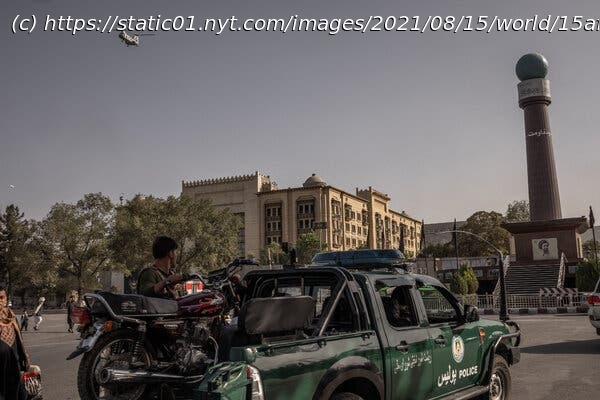The insurgents, after seizing control of the eastern city of Jalalabad, encircled the Afghan capital. A senior American official said key diplomatic staff had been moved to a compound at the airport.
The insurgents, after seizing control of the eastern city of Jalalabad, encircled the Afghan capital. A senior American official said key diplomatic staff had been moved to a compound at the airport. The Taliban enter Kabul, the last government stronghold. A frenzied U.S. flight from Kabul as chaos descends. Officials in Washington are scrambling to keep up with the fast-moving events in Afghanistan. ‘No going forward’: Kabul residents await the Taliban with dread and resignation. In pictures: The Taliban plant their flag. Afghan women wonder what will happen if the Taliban are once again in power. A history of U.S. miscalculation is compounded by the lack of an exit plan. The Taliban’s relentless, rapid advance across Afghanistan brought them into the capital, Kabul, on Sunday as the last major city controlled by the government fell into chaos. As it became clear that members of the Taliban had entered the gates of the capital, thousands of Afghans who had sought refuge there after fleeing the insurgents’ brutal military offensive watched with growing alarm as the local police seemed to fade from their usual checkpoints. At 6:30 p.m. local time, the Taliban issued a statement that their forces were moving into police districts in order to maintain security in areas that had been abandoned by the government security forces. Zabiullah Mujahid, spokesman for the Taliban, posted the statement on his Twitter feed. “The Islamic Emirates ordered its forces to enter the areas of Kabul city from which the enemy has left because there is risk of theft and robbery,” the statement said. The Taliban had been ordered not to harm civilians and not to enter individual homes,” it added. “Our forces are entering Kabul city with all caution.” As the sun set behind the mountains in the western part of the city, the traffic was clogged up as crowds grew bigger, with more and more Taliban fighters appearing on motorbikes, police pickups and even a Humvee that once belonged to the American sponsored Afghan security forces. Earlier in the afternoon Interior Minister Abdul Sattar Mirzakwal had announced that an agreement had been made for a peaceful transfer of power for greater Kabul and his forces were maintaining security. “The city’s security is guaranteed. There will be no attack on the city,” he said. “The agreement for greater Kabul city is that under an interim administration, God Willing, power will be transferred.” With rumors rife and reliable information hard to come by, the streets were filled with scenes of panic and desperation. “Greetings, the Taliban have reached the city. We are escaping,” said Sahraa Karimi, the head of Afghan Film, in a post shared widely on Facebook. Filming herself as she fled on foot, out of breath and clutching at her headscarf, she shouted at others to escape while the could. “Hey woman, girl, don’t go that way,” she called out. “Some people don’t know what is going on,” she went on. “Where are you going? Go quickly.” Wais Omari,20, a street vendor in the city, said the situation was already dire and he feared for the future. “If it gets worse, I will hide in my home,” he said. The United States military stepped up its evacuation of American diplomatic and civilian staff. A core group of American diplomats who had planned to remain at the embassy in Kabul were being moved to a diplomatic facility at the international airport, where they would stay for an unspecified amount of time, according to a senior United States official. On the civilian side of the airport, a long line of people waited outside the check-in gate, unsure if the flights they had booked out of the country would arrive. After days in which one urban center after another fell to the insurgents, the last major Afghan cities that were still controlled by the government, other than Kabul, were seized in rapid succession over the weekend. The insurgents took Mazar-i-Sharif, in the north, late on Saturday, only an hour after breaking through the front lines at the city’s edge. Soon after, government security forces and militias — including those led by the warlords Marshal Abdul Rashid Dostum and Atta Muhammad Noor — fled, effectively handing control to the insurgents. On Sunday morning, the Taliban seized the eastern city of Jalalabad. In taking that provincial capital and surrounding areas, the insurgents gained control of the Torkham border crossing, a major trade and transit route between Afghanistan and Pakistan. The Taliban offensive, which started in May when the United States began withdrawing troops, gathered speed over the past week. In city after city, the militants took down Afghan government flags and hoisted their own white banners. Despite two decades of war with American-led forces, the Taliban have survived and thrived, without giving up their vision of creating a state governed by a stringent Islamic code. After the Taliban took control of Afghanistan in the 1990s, movie theaters were closed, the Kabul television station was shut down and the playing of all music was banned. Schools were closed to girls. Despite many Afghans’ memories of years under Taliban rule before the U.S.-led invasion in 2001, the insurgents have taken control of much of the country in recent days with only minimal resistance. Their rapid successes have exposed the weakness of an Afghan military that the United States spent more than $83 billion to support over the past two decades. As the insurgents’ campaign has accelerated, soldiers and police officers have abandoned the security forces in ever greater numbers, with the cause for which they risked their lives appearing increasingly to be lost. Mr. Ghani, the Afghan president, had resisted pressure to step down. In a recorded speech aired on Saturday, he pledged to “prevent further instability” and called for “remobilizing” the country’s military. But the president was increasingly isolated, and his words seemed detached from the reality around him. On Sunday, Tolo TV, one of Afghanistan’s main independent channels, relayed that “two sources” had said that Mr. Ghani had left the country, adding that it was not clear where he was headed. Lotfullah Najafizada, head of news at Tolo TV, said in a Twitter post that Mr. Ghani had departed with his core team. Abdullah Abdullah, former chief excutive of the government and head of the High Peace Council, criticized Mr. Ghani for leaving his people and country. “That the former president of Afghanistan has left the country and its people in this bad situation, God will call him to account and the people of Afghanistan will make their judgment.” The speed of the Taliban’s advance has thrown exit planning into disarray. While many analysts had believed that the Afghan military could be overrun after international forces withdrew, they thought it would happen over months and years. Now it risks being completed in a matter of days and weeks. President Biden has accelerated the deployment of an additional 1,000e troops to Afghanistan to help get American citizens out. He made it clear that he would not reverse his decision to withdraw all combat forces. “I was the fourth president to preside over an American troop presence in Afghanistan — two Republicans, two Democrats,” Mr. Biden said on Saturday afternoon. “I would not, and will not, pass this war onto a fifth.” As the Taliban stood at the gates of Kabul on Sunday, completing the near total takeover of Afghanistan two decades after the American military drove them from power, an eerie quiet that had enveloped the city in recent days transformed into chaos. A frenzied evacuation of U.S. diplomats and civilians kicked into high gear, while Afghans made a mad dash to the banks, their homes and the airport. Crowds of people ran down the streets as the sound of gunfire echoed in downtown Kabul. Helicopter after helicopter — including massive Chinooks with their twin engines, and speedy Black Hawks that had been the workhorse of the grinding war — touched down and then took off loaded with passengers. Some dispensed flares overhead, a new addition to Kabul’s skyline. Those being evacuated included a core group of American diplomats who had planned to remain at the embassy in Kabul, according to a senior administration official. They were being moved to a compound at the international airport, where they would stay for an unspecified amount of time, the official said. The tarmac of the airport was filled with a constellation of uniforms from different nations. They joined contractors, diplomats and civilians all trying to catch a flight out of the city.
Start
United States
USA — Science Afghanistan Live Updates: Taliban Advances on Kabul; U.S. Evacuation Accelerates






